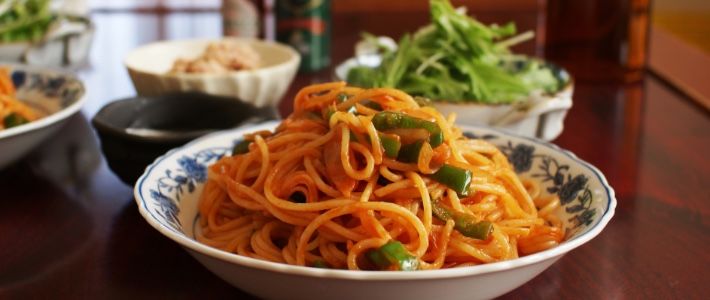
“Naporitan” and Other “Yōshoku” Cuisine
Culture Lifestyle- English
- 日本語
- 简体字
- 繁體字
- Français
- Español
- العربية
- Русский
UNESCO’s recent decision to designate traditional Japanese cuisine, or washoku, an Intangible Cultural Heritage, has focused new attention on Japan’s “indigenous” food culture.
But washoku is only half the story of culinary life in Japan; there’s also its counterpart, yōshoku, which could be defined as Japanese-style Western food. Some of Japan’s best-loved dishes, including much of its “comfort food,” falls under this category—things like omuraisu, korokke, and Japanese curry.(*1)
However exotic or “ethnic” such dishes may have seemed to Japanese at first, they eventually became an integral part of the country’s cuisine, in much the same way that Americans transformed pizza.
To the purists, some of this tweaking of another country’s cherished recipes may seem an unappetizing abomination; and they’re not always wrong (I’m looking at you, Taco Bell). But without this history of culinary cross-pollination there’d be a lot fewer choices on the menu.
One typical yōshoku dish is “Naporitan”—a spaghetti concoction that bears only a superficial resemblance to its apparent namesake, Spaghetti alla Napoletana.
You don’t need many ingredients to make Naporitan: some spaghetti, of course, and onion, green bell peppers, mushrooms, sausage (or ham), and ketchup. Just boil the pasta while frying up the other ingredients, and then mix it all together in the frying pan with a healthy glob of ketchup. There are plenty of recipes and videos out there for anyone who wants to try at home.
The dish seems to be loved less for its taste than for the nostalgia it evokes. For the 50-and-older crowd, especially men, the Naporitan ordered for lunch at an old, rough-at-the-edges café can trigger a delectable Proustian moment to chew over. Just the name of this simple spaghetti dish seems to evoke the mid-Shōwa era, from around the mid-1950s to mid-1970s; a period of nonstop growth that has nonetheless come to be seen as a “simpler time.”
The standard account of the history of Naporitan is that it was thought up just after World War II by Irie Shigetada, the head chef at the Hotel New Grand in Yokohama. He drew his inspiration, if you can call it that, from the simple meals of spaghetti and ketchup he saw the occupying soldiers scarfing down. Irie replaced the ketchup with tomato puree, and added other ingredients like onion, ham, and mushrooms. And his original version of the dish can still be sampled at The Café of the Hotel New Grand.
He chose the name “Naporitan,” apparently, in reference to the simple tomato and spaghetti dishes served in Naples. But some have said that in prewar Japan there were already references in cookbooks to dishes cooked Napori-fū—in other words, alla Napoletana. Those with even more time on their hands have tracked down an entry in the published diary of the Japanese comedian Furukawa Roppa that notes how he ate a tasty “Naporitan” dish at a restaurant in the Mitsukoshi. So even if the Naporitan did not exist in its latter-day apparition, the word may already have been in use some time earlier.
Whatever the exact origin of Naporitan, it is clear that the dish was a sort of bridge between the noodle dishes that Japanese had been accustomed to eating and the Italian cuisine that was later common in Japan.
Before Naporitan became a part of postwar Japanese cuisine, the most popular pasta dishes were made with macaroni, such as oven-baked gratin dishes that could be served with rice. And most of that pasta was imported, since it had yet to be produced on a wide scale domestically.
This changed after the war, when the huge influx of wheat from the United States led the mass production (and consumption) of pasta. And the massive amount of ketchup that flowed into Japan was the other factor behind the Naporitan phenomenon. (Since tomato puree was a bit harder to come by most people made the dish using ketchup.)
The cavalier use of ketchup—instead of a tomato sauce like’a momma used to make—is not Naporitan’s only culinary crime by today’s standards. There is also the sodden spaghetti itself—al dente, it is not.
The sogginess was partly due to the softer type of flour used to make the noodles, since semolina was only introduced to Japan around the 1980s. But another reason is that mushy spaghetti would have had a reassuring familiarity for those familiar with noodle dishes like yaki udon.
Even the way it was prepared by adding the ketchup concoction at the very end, was similar to how a sauce is added right at the end of making stir-fried noodles. It wasn’t the Italian way of doing things, certainly, but it set Japanese stomachs at ease in those days. The original Hotel New Grand recipe calls for the spaghetti to be made as soft as possible by first half-cooking it, setting it aside for a few hours, and then boiling it a second time.
Nowadays, Japanese largely prefer a more “authentic” approach to Italian cuisine—much like the trend among American diners as well. But just as Americans remain fond of their home-grown versions of pizza or lasagna, there's still room in Japan for the humble Naporitan.
(Banner photo courtesy Nozaki Tomoya.)
(*1) ^ Curry apparently falls under the “Western” category because it was introduced to Japan via the British Navy.